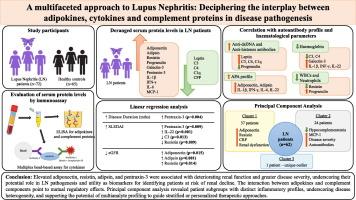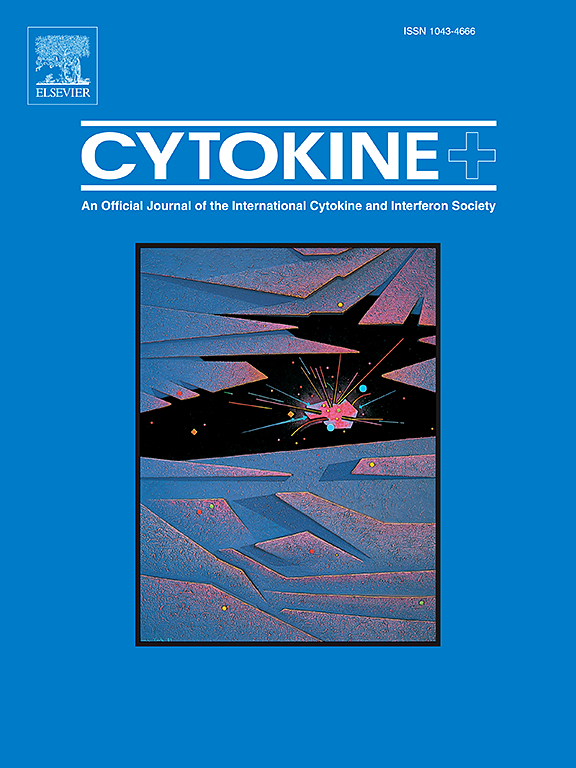A multifaceted approach to lupus nephritis: Deciphering the interplay between adipokines, cytokines and complement proteins in disease pathogenesis
IF 3.7
3区 医学
Q2 BIOCHEMISTRY & MOLECULAR BIOLOGY
引用次数: 0
Abstract
Background
The pro- and anti-inflammatory adipokines secreted by closely located visceral adipose tissue (VAT) have showed to modulate the inflammatory milieu around kidneys. In this study, we investigate the interplay between adipokines, cytokines and complement proteins in lupus nephritis patients.
Materials and methods
Treatment naïve renal biopsy proven (2003 ISN/RPS) LN patients (n = 72) and healthy volunteers (n = 65) were enrolled (January 2017–January 2021). Serum adipokines, cytokines, complement proteins, C- reactive protein, Antinuclear antibodies (ANA) profile, anti-dsDNA antibodies and anti-phospholipid antibody (APA) profile were estimated using immunoassay. Serum C3 and C4 levels were measured by nephelometer.
Results
Elevated adiponectin, adipsin, resistin, progranulin, galectin-3 and pentraxin-3 levels and reduced leptin levels were seen in LN patients when compared to healthy controls (p < 0.05). Serum IL-1β, INFγ, IL-6 and MCP-1 levels were significantly elevated whereas IL-4 levels were prominently reduced in LN patients when compared with healthy controls (p < 0.05). Serum C1q and CFP levels were significantly reduced in LN patients (p < 0.05). Elevated pentraxin-3 levels directly correlated with long disease duration and high SLEDAI score (p < 0.05). Declining renal function parameters strongly correlated with raised adiponectin, adipsin and resistin levels (p < 0.05). Adipsin levels positively correlated with complement components C3, C4 and CFB levels (p < 0.05). The PCA of serum proteins in LN patients identified three distinct clusters comprising of 37 (Cluster1), 24 (Cluster2) and 1 (Cluster3) patients in each. Adiponectin, resistin and CRP levels were found to be elevated in patients belonging to Cluster1. On the contrary, MCP1 levels were raised in Cluster2 LN patients.
Conclusion
The association of raised resistin, adipsin, pentraxin-3 levels with deteriorating renal function is suggestive of their potential role in LN pathogenesis. The association between adipokines and complement components indicates the regulatory role of adipokines on complements and vice versa. The identification of patient clusters based on serum protein profile indicated involvement of unique biological profiles in diverse LN pathogenesis mechanism.

狼疮性肾炎的多层面研究:解读脂肪因子、细胞因子和补体蛋白在疾病发病机制中的相互作用
近距离内脏脂肪组织(VAT)分泌的促炎性和抗炎性脂肪因子可以调节肾脏周围的炎症环境。在这项研究中,我们探讨了脂肪因子,细胞因子和补体蛋白在狼疮肾炎患者中的相互作用。材料和方法治疗方法naïve肾活检证实(2003 ISN/RPS) LN患者(n = 72)和健康志愿者(n = 65)入组(2017年1月- 2021年1月)。采用免疫分析法测定血清脂肪因子、细胞因子、补体蛋白、C-反应蛋白、抗核抗体(ANA)谱、抗dsdna抗体和抗磷脂抗体(APA)谱。用浊度计测定血清C3、C4水平。结果LN患者脂联素、脂素、抵抗素、前颗粒素、半乳糖凝集素-3和戊素-3水平升高,瘦素水平降低(p <;0.05)。与健康对照组相比,LN患者血清IL-1β、INFγ、IL-6和MCP-1水平显著升高,IL-4水平显著降低(p <;0.05)。LN患者血清C1q和CFP水平显著降低(p <;0.05)。pentaxin -3水平升高与病程长、SLEDAI评分高直接相关(p <;0.05)。肾功能指标下降与脂联素、脂素和抵抗素水平升高密切相关(p <;0.05)。Adipsin水平与补体成分C3、C4和CFB水平正相关(p <;0.05)。LN患者血清蛋白的PCA鉴定出三个不同的集群,每个集群包括37例(Cluster1), 24例(Cluster2)和1例(Cluster3)患者。脂联素、抵抗素和CRP水平在Cluster1患者中升高。相反,Cluster2 LN患者的MCP1水平升高。结论抵抗素、脂肪素、戊二醇-3水平升高与肾功能恶化的关系提示其在LN发病中的潜在作用。脂肪因子和补体成分之间的关联表明脂肪因子对补体的调节作用,反之亦然。基于血清蛋白谱的患者聚类鉴定表明,不同的LN发病机制涉及独特的生物学谱。
本文章由计算机程序翻译,如有差异,请以英文原文为准。
求助全文
约1分钟内获得全文
求助全文
来源期刊

Cytokine
医学-免疫学
CiteScore
7.60
自引率
2.60%
发文量
262
审稿时长
48 days
期刊介绍:
The journal Cytokine has an open access mirror journal Cytokine: X, sharing the same aims and scope, editorial team, submission system and rigorous peer review.
* Devoted exclusively to the study of the molecular biology, genetics, biochemistry, immunology, genome-wide association studies, pathobiology, diagnostic and clinical applications of all known interleukins, hematopoietic factors, growth factors, cytotoxins, interferons, new cytokines, and chemokines, Cytokine provides comprehensive coverage of cytokines and their mechanisms of actions, 12 times a year by publishing original high quality refereed scientific papers from prominent investigators in both the academic and industrial sectors.
We will publish 3 major types of manuscripts:
1) Original manuscripts describing research results.
2) Basic and clinical reviews describing cytokine actions and regulation.
3) Short commentaries/perspectives on recently published aspects of cytokines, pathogenesis and clinical results.
 求助内容:
求助内容: 应助结果提醒方式:
应助结果提醒方式:


